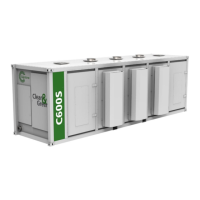Capstone Turbine Corporation • 16640 Stagg Street • Van Nuys • CA 91406 • USA
Installation Guide: Capstone C1000S/C800S/C600S with C1000 Series Controller
480064 Rev C (December 2018) Page 65 of 122
Capstone reserves the right to change or modify, without notice, the design, specifications, and/or contents of this document without
incurring any obligation either with respect to equipment previously sold or in the process of construction.
6.5.10. Black Start/Dual Mode Considerations
There are unique concerns for fuel delivery when the microturbine is off grid, which occurs in
standalone or dual mode applications. When not connected to a grid, the AC electrical bus will be
“black” (zero voltage), and starting the microturbine in this state is known as a “black start.” Until
the microturbine enters load state, auxiliary systems that rely on the AC bus for power will require
an alternative power supply for this black start period. This means that an external gas
compressor and other fuel system auxiliaries, such as dryers, automatic valves, and condensate
equipment, will need an external power source during a black start.
Two common black start power supplies include a small piston generator or a UPS system. The
black start power supply should be rated for the voltage, power, and time requirements of the
black start period. The transition from black start power supply to microturbine power supply is a
critical period, since the microturbine needs to remain operational through this transition.
Controllers generally include dedicated UPS systems that can ride through short outages, but
these will not generally help for the larger compressor and auxiliary power supply requirement.
6.6. Liquid Fuel
Liquid fuels and liquid fuel delivery systems vary greatly from gaseous fuels. Liquid fuels are
commercially available in a variety of different forms, such as gasoline, diesel fuel, biodiesel, and
jet fuel. Certain oil and gas installations will also have access to fuels such as raw gasoline and
diesel, liquid hexanes, kerosene and heavy gas oils. Due to the continuous combustion process
of a microturbine and Capstone’s experience using some of these fuels, not all of these liquid
fuels are acceptable for use in a microturbine.
Liquid fuels are not similar to gaseous fuels, and therefore special consideration must be taken
with every component in the liquid fuel system. If installing a liquid fuel system, refer to the Liquid
Fuel Application Guide (Table 1) and C1000 Liquid Fuel Pretreatment P&ID (Table 1) for
information on allowable fuels, properties, requirements, and delivery.

